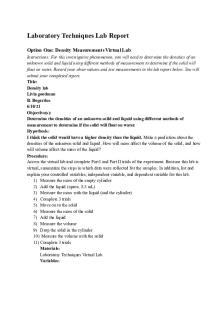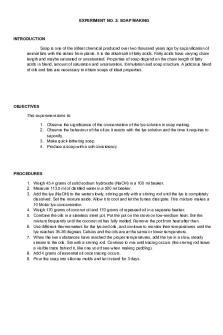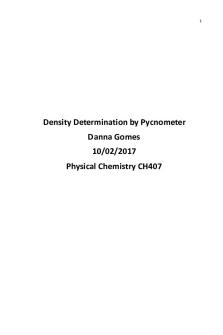Laboratory report - aspirin PDF

| Title | Laboratory report - aspirin |
|---|---|
| Course | Analytical chemistry |
| Institution | Coventry University |
| Pages | 8 |
| File Size | 202.1 KB |
| File Type | |
| Total Downloads | 96 |
| Total Views | 150 |
Summary
Essay on aspirin ...
Description
Author: Kauser Hussain. Laboratory report on how aspirin and its properties. Introduction Aspirin is a nonsteroidal anti-inflammatory drug which can be used as a pain killer. It is used to reduce any swelling in the body. The drug has a type of anti-clotting factors which are also known as anticoagulants which thinness the blood. Aspirin also has antiplatelet factors which prevents blood clots such as blood cells from clumping together. Aspirin is a soluble drug which can be crystallised and has a unique melting point so can be separated from other substances by melting as solidifying. The mass of 1 mole of acetylsalic acid is 180.16 grams. Metabolism occurs inside the liver and the IUPAC name of this substance is 2-Acetoxybenzoic acid. The drug bank of aspirin is DB00954. The drug can be used to reduce any pain which can result from disease. Aspirin has a chemical compound formula of C9H8O4. Aspirin has a chemical name of acetylsalic acid. Acetylsalic acid is made up of 6 carbon cycloalkene known as cyclohexene and ethanoic acid, and methanoic acid (Rainsford 2004). Salicylic acid is a solution which is used to make aspirin. It can be used in medicine to remove the outer layer of the skin. This can be used to treat skin conditions such as warts, ringworms, acne, dandruff, and other affected areas. Salicylic acid has the formula of C7H6O3. It has the boiling point of 211 0C and melting point of 158.60C and had the density of 1.44 g/cm3. The IUPAC names of this substance is 2Hydroxybenzoic acid. The molar mass of this substance is 138.21 g/mol. The purity of the acetylsalic acid can be found by using melting point apparatus, also known as the melt stati on, and spectrophotometer. Melting point apparatus can be used to test the purity of the aspirin tablet. This can be by using instruments to determine the melting point of the substance. Spectrophotometer is a quantitative measurement of reflection or transmission. This is done by transmitting wavelength towards the compound. The compound can either absorb and transmit the wavelength at different angles and wavelengths (Pavia 2004). Chromatography is a physical method of separation a mixture of materials within a solution. This distributes compounds into different phases. The mixture is dissolved in fluid which is called the mobile phase. The mixture is separated by traveling inside the machine (Heftsmann 2004). Vacuum filtration is when solids are separated from the liquids. The solids are crystallised. To purify them, they can be rinsed with distilled water. Iron (III) nitrate is a chemical compound which has a formula of Fe(NO3)3. It has the boiling point of 1250C and the melting point of 47.2 0C. It has the density of 1.68 cm3. This substance is soluble in both water and alcohol. The molar mass of this substance is 241.68 g/mol. Ethanol is an alcohol and has the chemical formula of C2H4OH. It can be used as a solvent and it is a colourless liquid. It can be used as a disinfectant. Ethanol can be used as a drug to depress the brain which can slow down the central nervous system. When ethanol is ingested by the human body and can be absorbed by the
gastrointestinal tract which is then distributed through out the body. Ethanol has the boiling point of 78.370C and the melting point of -114.1 0C. The molar mass of this substance is 46.07 g/mol. The density of this substance is 789 kg/m 3 (Anon). The rate of reaction is the speed at which a chemical reaction proceeds. Le Chateliers principle states that change in pressure, temperature and concentration of the reactants can affect the rate of the reaction. Equilibria is when a chemical reaction is at a constant state, so the number of reactants and products produced are constant and remain the same. The aim of the experiment was to find the IR frequency of aspirin, the melting point of the aspirin and the spectrophotometric absorbance reading of aspirin with solution. Method Part one of the experiment is to find the infrared spectroscopy of the synthesised aspirin which was tested using a chromatogram. Part two of the experiment is used to test the melting temperature of aspirin was determined using melt station which is also known as melting point apparatus. The aspirin tablets were crushed using pestle and mortar. The temperature of the melting point apparatus was set at 125oC. The capillary tube was placed into the sample holder of the melting point apparatus. The start button was pressed which caused the set plateau temperature to heat up. The melting temperature range by the temperature at which the first drop of liquid appears. After this, the liquid disappears. After the aspirin has melted, the stop button of the melt station is pressed which cools the equipment down. The melting point apparatus experiment is repeated. Part three of the experiment is when iron (III) nitrate is mixed with salicylic acid into the aspirin tablet which is a blue/purplish colour. This solution is then placed into the spectrophotometric absorbance of aspirin. Five standard solution were produced. The stock solution was produced, which was called trial 1, by preparing 250 mL of a 5.79 × 10 -3 mol/L stock salicylic acid. The 100 mL standard solution was produced by transferring 10 mL of stock salicylic acid to a 100 mL volumetric flask. The stock solution was used to produce diluted solutions. Trial 2 was produced by putting 2 ml of stock solution with 2 ml of water. Trial 3 was made up by putting 2 ml of stock solution with 4 ml of water. Trial 4 was produced by producing 2 ml of stock solution with 6ml of distilled water. Trial 5 was produced by mixing 2 ml of stock solution with 8 ml of distilled water. Absorbance reading of each solution was taken. Part four of the experiment is when 1 ml of Fe(NO3)3 was placed inside the spectrophotometer with a wavelength of 530nm. The absorbance reading was taken. Part five of the experiment is when 0.04 grams of aspirin was placed into a 25 ml beaker. 1ml of ethanol was placed into the beaker. 15 ml of distilled water was added into the beaker. The solution from the beaker was poured into a 25ml volumetric flask. Distilled water was added into a volumetric flask until 25ml was reached. 5ml of the solution made up was placed into a 100 ml volumetric flask. 1 ml of the solution was added into a cuvette. The absorbance reading was taken of this solution.
Results Table 1 shows the results for the melting point apparatus experiment for part two of the experiment. 138 to 1400C
Rough melting temperature range of synthesized aspirin (0C)
1380C
Accurate Melting temperature range of synthesised aspirin (0C)
138 to 1400C
Melting temperature range of commercial aspirin (0C)
Table 2 shows the results for part three of the experiment. Initial mass of salicylic acid (g)
0.04 grams
Moles of salicylic acid (mol)
0.04/138 = 2.899 Moles/volume(liters) 2.899/0.0250=115.96
Initial molarity of salicylic acid (mol/L)
Table 3 shows the absorbance reading for the solution sample for part three of the experiment. This is the concentration and absorbance reading.
Ratio of salicylic acid to distilled water
Concentration of (mol/L)
Absorbance (nm)
1
1:0
0.02899
-0.563
2
4:1
0.03624
-0.300
3
3:2
0.0483
-0.257
4
2:3
0.0060
-0.128
5
1:4
0.14495
-0.050
Graph 1 - Absorbance reading of aspirin in salicylic acid (nm)
0
Aspirin absorbance reeading within aslicylic acid solution (nm)
0
1
2
3
-0.1
4
5 -0.05
-0.128
-0.2 -0.257 -0.3 -0.3
-0.4
-0.5 -0.563
-0.6
Trial
Graph 1 is a graph which shows the absorbance reading of aspirin in salicylic aid at a 530 wavelength in (nm).
Table 4 shows the results for part 5 of the experiment. Initial mass of aspirin sample (grams) Absorbance of aspirin sample in nanometers (nm)
Table 5 shows results for part three of the experiment
0.04 grams 0.001 nm
6
Concentration of salicylic acid (mol/Litre)
Mole/volume 2.899/0.001= 0.002899
Moles of 1Fe(NO3)3 = 1/241.85 = 0.00413 MR of Fe(NO3)3 = 241.85 Spectrophotometric reading of 0.005 nm
Discussion A chromatogram is a method which can be used to separate a mixture of solutions which contain different compounds. This can be used to purify the aspirin. The advantages of using chromatogram is that this method is used to separate the mixture of solutions, so the material needed such as aspirin can be extracted using chromatogram. This method can be done quickly and easily. The limitations to this experiment is that it is expensive to use (Heftsmann 2004). The results of the melting point apparatus shows the melting point of the aspirin. The melting point of the drug can determine how pure the substance is. An electronic melting point apparatus can be used instead to find the melting point of aspirin . It is important to ensure that the aspirin is as pure as possible as it can be used to cure the fever and any other illness the patient has. The advantage of this experiment is that it is quick to use to find out the temperature of aspirin, and it is easy to carry out the experiment to find the results of the experiment. This method can be used to find the out how pure the aspirin is. Limitations of this experiment is that melting point apparatus is quite expensive. This experiment can only be done on solids (Pavia 2004). Table 3 shows the different concentration of salicylic acid was made up and the absorbance was measured and compared with other concentrations of salicylic acid. The absorbance reading shows the amount of light which is absorbed by the solutions being tested which was done by 530 nm visible wavelength. The concentration of salicylic acid can be altered by using distilled water. The concentration of salicylic acid can be lowered by adding distilled water. As the concentration of salicylic acid is lowered, the absorbance reading will increase. This means that the lower the concentration of salicylic acid, the higher the value of the absorbance reading so the solution has absorbed more wavelength of light. Graph 1 shows that there is a negative correlation between the concentration of the concentration of the solution which contains salicylic acid and aspirin and the absorbance reading.
The solution of each trail adds up to 10 ml. For each trial, the level of salicylic acid decreases, and the level of distilled water added increases. The different levels of salicylic acid and distilled water is different in each trial. Distilled water is non-ionised water and contains only water molecules which are H2O. The hydrogen atoms are partially positive, and oxygen is partially negative. Water molecules are attracted to each other using hydrogen bonds. Mole=mass/molar mass; 0.04/138 =0.0002899 Spectrophotometers can be used to identify the amount of salicylic acid in the aspirin sample. This part of the experiment to identify the contamination of salicylic acid using a spectrophotometer can be used to find a reading. This can be used to find how much salicylic acid can be used to identify the amount of acid found in the aspirin. Not reliable as solution of iron (III) nitrate as added into the aspirin solution. The concentration of iron (III) nitrate can vary. As the solution become more diluted, the level of iron (III) nitrate will decrease. As the concentration of salicylic acid decreases, the absorbance reading of salicylic acid increases from – 0.563 to -0.050 nm. Other methods such as pH testing can be used to determine the amount of salicylic acid there is in the aspirin sample. There are several pH testing methods such as pH strips and universal indicators. This can be used to determine the acidity of the pH of the solution to be more acidic, so the indicator will state the pH is less than 7. Spectroscopy is a method which can be used to identify how pure the aspirin produced is. This is done by checking the percentage of aspirin in each tablet of aspirin. The advantage of this experiment is that using a spectrophotometer is quick and easy to use to find the absorbance reading of the solutions. Limitation to this experiment is that colour was added to the salicylic acid which was a blueish purple colour. This can affect the absorbance reading of the solution. Iron (III) nitrate was mixed with the salicylic acid which can also have an impact on the absorbance reading. 1ml of iron (III) nitrate was placed into a spectrophotometer and the absorbance reading of 0.005 nm was taken. This absorbance reading shows that a low level of visible light is absorbed by the iron (III) nitrate. The advantages of the experiment is that finding the absorbance reading of the solution was quick and easy to find. The limitation of the experiment is that spectrophotometer is quite expensive piece of equipment. Accurate results can be found by putting an accurate amount of solution into the spectrophotometer. During part 5 of the experiment, aspirin was mixed in with ethanol. The aspirin was the solute whilst the ethanol was the solvent. This means that the aspirin dissolves completely in ethanol. This solution is then diluted using distilled water. This reduces
the concentration of the reactants and products of the reaction. Temperature, pressure, and concentration of reactants can have an effect of the experiment. Le Chateliers principle is used to explain how concentration of reactants, pressure of the molecules within the solution and how temperature can have an impact on the amount of products produced within the reaction. This can be used to ensure more aspirin is produced. This is done by ensuring that the equilibrium shifts to ensure more of the product is produced. Aspirin can be synthesised by reacting salicylic acid with acetic anhydride to form acetylsalicylic acid and acetic acid. The forward reaction to produce aspirin is endothermic, so energy, such as heat, can be used to break down the reactants. The reactants form products by electrostatic forces of attraction. The products can take place in a reversible reaction, so the aspirin can break to form the reactants products of the aspirin synthesis reaction. Health and safety is important as it can prevent accidents and injuries. This can be carried out by ensuring that laboratory coats, goggles and gloves are worn. This ensure the skin and eyes have no contact with the corrosive substances. No eating or drinking can be allowed and ensuring that windows remain closed and the extractor fan be used. The temperature should remain constant and doors should remain closed. Any solutions should remain in the containers. Any excess equipment should be cleared. Comparison of experiment 3 with 5 shows that aspirin has a higher absorbance reading when ethanol is used as a solvent. Water can be used as a solvent for dissolving aspirin. Experiment 2 shows the melting point of the aspirin. Conclusion In conclusion, the aim of the experiment was met. The absorbance reading of aspirin mixed in with salicylic acid and iron (III) nitrate was taken. The melting point of aspirin was determined using the melting point apparatus. The infrared spectroscopy reading was taken by using a chromatogram. The absorbance reading of aspirin mixed with ethanol.
References 1. Anon. Iron(III) nitrate. (2016) In Wikipedia, Iron (III) nitrate). Available from 2. Heftsmann, E. (2004) Chromatography: Fundamentals and application of chromatography. 6th edn. Netherlands; Elsevier 3. National centre for Biotechnology Information, U.S National Library of Medicine. (2018) Ethanol. Available online https://pubchem.ncbi.nlm.nih.gov/compound/ethanol#section=DepositorSupplied-Synonyms [19/01/2018] 4. Pavia, D. (2005) Introduction to organic Laboratory Techniques: a small scale approach. United States of America; Thomson Brooks/Cole
5. Rainsford, K. (2004) Aspirin and related drugs. United States of America; Taylor and Francis 6. McMurry, J. (1996) Organic chemistry. 4th edn. United States of America; Brooks/Cole Publishing Company 7. Christian, G. (2004) Analytical Chemistry. 6th edn. Sahibabad, UP; Wiley...
Similar Free PDFs

Laboratory report - aspirin
- 8 Pages

Aspirin Synthesis Lab Report
- 5 Pages

Aspirin Analysis Lab Report
- 6 Pages

Aspirin synthesis Lab report
- 6 Pages

Lab 1 - Laboratory Report
- 10 Pages

Laboratory+report+1-4
- 11 Pages

Laboratory 11 - Lab Report
- 3 Pages

Laboratory Report 1 SKO3023
- 30 Pages

Aspirin
- 5 Pages

Synthesis of aspirin lab report
- 12 Pages

EXP#2 - Aspirin lab report
- 10 Pages

Laboratory Report Rubric
- 2 Pages

Laboratory Techniques Lab Report
- 4 Pages
Popular Institutions
- Tinajero National High School - Annex
- Politeknik Caltex Riau
- Yokohama City University
- SGT University
- University of Al-Qadisiyah
- Divine Word College of Vigan
- Techniek College Rotterdam
- Universidade de Santiago
- Universiti Teknologi MARA Cawangan Johor Kampus Pasir Gudang
- Poltekkes Kemenkes Yogyakarta
- Baguio City National High School
- Colegio san marcos
- preparatoria uno
- Centro de Bachillerato Tecnológico Industrial y de Servicios No. 107
- Dalian Maritime University
- Quang Trung Secondary School
- Colegio Tecnológico en Informática
- Corporación Regional de Educación Superior
- Grupo CEDVA
- Dar Al Uloom University
- Centro de Estudios Preuniversitarios de la Universidad Nacional de Ingeniería
- 上智大学
- Aakash International School, Nuna Majara
- San Felipe Neri Catholic School
- Kang Chiao International School - New Taipei City
- Misamis Occidental National High School
- Institución Educativa Escuela Normal Juan Ladrilleros
- Kolehiyo ng Pantukan
- Batanes State College
- Instituto Continental
- Sekolah Menengah Kejuruan Kesehatan Kaltara (Tarakan)
- Colegio de La Inmaculada Concepcion - Cebu


